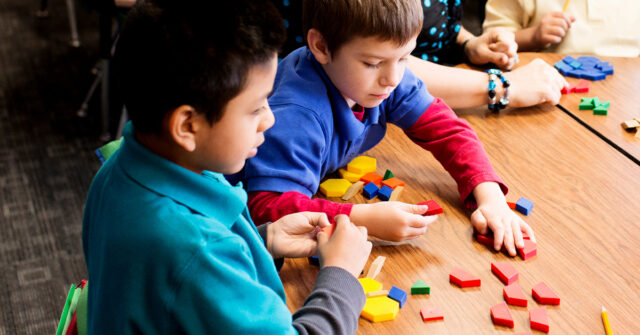
In a room filled with conversation, a student leans forward, eyes bright, and says, “I got it!” That moment signals more than just a correct answer. It reflects a learning environment where students feel safe to speak, explore, and grow.
Dr. Karen Fuson, program author of Math Expressions, describes this environment as the Nurturing Math Talk Community. “Nurturing because students have to feel they belong and that their voice can be heard,” she explains.
This sense of belonging is not accidental. It is built through five research-based core structures that support every learner’s needs: math talk, building understanding, student leaders, quick practice, and the helping community. “These were terms that I found early on really were understood by teachers,” Fuson says.
The idea of the Nurturing Math Talk Community and its key components emerged from the Children’s Math Worlds Research Project (CMW), which was instrumental in the development of the Math Expressions curriculum. These core structures work together to create space for differentiated learning and shared success, recognizing that differentiated learning begins with a classroom culture that values every student’s voice.
In the video below, Fuson explains the Nurturing Math Talk Community.
Learn more about how these research-based structures can help students develop confidence and success in math.
The Five Core Structures of Math Expressions
These interactive, research-based structures work together to shape how students engage with math and one another. The following describes the role each component plays, as well as how this might look in a fourth-grade math classroom during a lesson on angle measurements:
1. Math Talk
Using Math Talk in the classroom provides students with many opportunities to deepen their understanding of concepts and clarify their mathematical thinking. Math Talk’s structure allows students to explain their solutions to problems, make generalizations about concepts, and analyze the structures of problems.
Here’s an example of math talk in the classroom:
Teacher: “How can you visually tell this angle is greater than 90 degrees, without using a protractor?”
Student: The angle appears wider than a right angle.
Teacher: “Can you be more specific?”
Student: “The angle appears wider than the corner of my book, which I believe is a right angle.”
Teacher: “Interesting! What about anyone else?”
2. Building Understanding
Building Understanding invites students to use math drawings or visual representations to make their thinking visible. Students can also explain their thinking with their peers.
When learning about angle measurements, students can build understanding by exploring the angles of different classroom items. Students could even draw the angles and discuss their drawings with their classmates.
3. Student Leaders
Student Leaders play a key role in an equitable and engaging classroom. They support their peers by helping to explain math concepts, giving students a chance to take charge of their learning. “It’s a way for students to grow and be teachers as well as learners,” Fuson explains.
For example, while practicing using protractors, students who are efficient at using the tool might act as leaders by helping their peers correctly use their protractors and read measurements.
4. Quick Practice
Quick Practice sessions offer students opportunities to strengthen readiness for a topic. These practice sessions can be as short as five minutes, and the entire class completes them together. Students should feel free to take risks and share their ideas. Additionally, student leaders can lead these practice sessions.
“They’re fast-paced . . . carefully chosen because they’re what students need to be good at before they can do a concept that’s coming down the next week,” Fuson says.
For example, at the start of a lesson on angle measurements, students might use their arms to quickly show their knowledge of right, acute, and obtuse angles, with student leaders leading the practice session.
5. The Helping Community
The Helping Community brings it all together. From the beginning of the year, the teacher creates a community where students lift each other up. Fuson explains: “There’s no competition. Nobody makes fun of anybody. Kids help each other.”
Here’s what a Helping Community might look like: While learning about angle measurements, peers help each other to use their protractors skillfully and double-check each other’s measurements.
How It All Connects
Ensuring equitable and engaging instruction, these five core structures create more than routines. They shape a culture where students feel seen and supported.
Math Talk helps students articulate their mathematical thinking. Visual representations of math concepts support Building Understanding while deepening student understanding of concepts. Quick Practice sessions prepare students for lessons. Student Leaders and the Helping Community foster a community where everyone feels safe to share their ideas, make mistakes, and lean on one another.
These structures work together to create a classroom community where understanding grows, confidence builds, and every student has a chance to say, “I got it.”
***
Explore how Fuson’s Math Expressions builds inclusive classrooms through its five core structures that elevate student voice, collaboration, and leadership. Get the program overview for more on what’s included, ensuring differentiated and engaging learning. Learn more.
Explore Math Expressions with instant access to the program overview.


